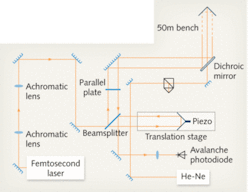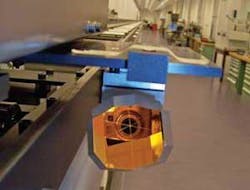Interferometric methods are often used for long-distance measurements in air that require high accuracy. However, these methods–which rely on measurement of optical phase–are either incremental, or require prior knowledge of the approximate distance being measured with subwavelength accuracy; otherwise, complex multiwavelength systems are needed.
To eliminate this phase ambiguity, researchers at the Technical University Delft (TU Delft) and VSL, the Dutch national metrology institute (both in Delft, The Netherlands) are analyzing the cross-correlation between pulses emitted from a stabilized frequency-comb laser in a Michelson interferometer to create a laser distance measurement. The method improves on previously reported high-accuracy, short-distance interferometric technology from the Korea Advanced Institute of Science and Technology (KAIST) in Daejeon, South Korea, by being the first experimental demonstration of long-distance (tens of meters) measurement in air using a femtosecond frequency-comb interferometer.
How accurate?
The Delft method has been compared to a conventional counting interferometer, showing agreement within 1 µm, with an uncertainty of 1 µm for distances up to 50 m. However, the achievable absolute accuracy of distance measurement in air is limited by the knowledge of the refractive index of air, which depends on the accuracy of the Edlén’s equation and the uncertainty on the measurement of the environmental conditions (air temperature, pressure, relative humidity, and CO2 content). For typical laboratory conditions (with uncertainties of temperature and pressure of 0.2°C and 0.5 hPa, respectively) this leads to an uncertainty of 25 µm for a 50 m distance measurement. The fact that the agreement between the counting interferometer and the frequency-comb method is much better demonstrates that the measurement accuracy is limited by knowledge of the air’s refractive index and not by the measurement method.
Compared to a recently announced frequency-comb-based light-detection-and-ranging (LIDAR) system developed by the National Institute of Standards and Technology (Boulder, CO), the Delft method uses only one femtosecond laser and is significantly simpler (and more cost effective). “With an extremely simple scheme we can reach the highest accuracy in air limited only by the refractive index,” says TU Delft researcher Moxi Cui. “The accuracy of distance measurement in air is always challenging since it is limited by the stability of the environmental conditions and the determination of the refractive index of air. One advantage of the frequency-comb method is the large range of nonambiguity, allowing for nonincremental measurement. Long-distance measurements in air are important for the monitoring of land masses, seismic movement, and low-Earth-orbit space applications.”
To implement the cross-correlation distance measurement, an 815 nm modelocked Ti:sapphire laser is used as the frequency-comb source, with both repetition frequency and carrier-envelope-offset (CEO) frequency (fixed at 180 MHz) referenced to a cesium atomic clock (see figures). The frequency-comb source has a pulse duration of 40 fs and a repetition rate of 1 GHz, which corresponds to a pulse-to-pulse distance of 30 cm. After collimation, the source is sent to a Michelson interferometer, with one part of the beam (the short reference arm) reflected by a corner cube mounted on a piezoelectric transducer, and the other part of the beam (the long measurement arm) reflected by another corner cube, which can be moved along a 50-m-long measurement bench. A correlation function is measured by overlapping the beams on an avalanche photodiode (APD) while the PZT is modulated.The smallest path-length difference between both arms in the setup is 0.9 m. By moving the long arm over distances corresponding to 20, 30, 40, and 50 m, cross-correlation functions can be recorded for a variety of long distances. A numerical model based on plane-wave propagation is implemented to account for the effects of air dispersion on the distance measurements. Not only did the measured results compare favorably with numerically modeled correlation results, but conversion of zero-path-length correlation functions to an optical spectrum using Gaussian curve fitting agreed well with spectral measurements from an Ocean Optics spectrometer.
REFERENCE
- M. Cui et al., Optics Letters 34(13) p. 1982 (July 1, 2009).


